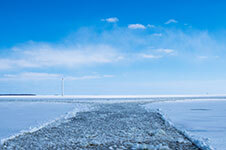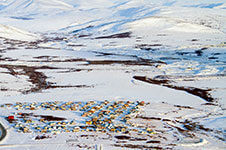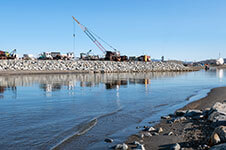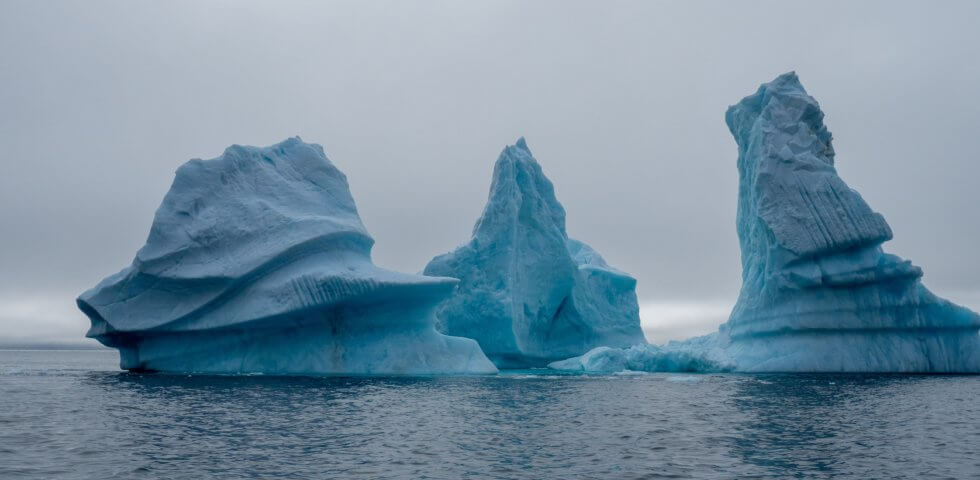If you’ve been following our story, then you likely already know that Quintillion is the first and only telecommunications operator to build a subsea and terrestrial fiber optic cable network in the US Arctic. This extensive cable system spans more than 1,700 miles along the Alaska coast and has brought the reliability and affordability of fiber optic internet access to rural communities in Nome, Kotzebue, Point Hope, Wainwright, Utqiaġvik, and Prudhoe Bay/Deadhorse.
While our vision for the Quintillion network is literally sky high, our leadership team has focused in on our main goals as we continue to expand and enhance our current offerings. As we build the road map for this year and next, the main goal of our current efforts is to continue furthering the In, Out, and Up strategy. Or, expanding our terrestrial network growth in Alaska, expanding our subsea network into other continents, and expanding up through supporting arctic ground station operations. Here is more on what you can expect from us.
Excited for what’s in store? Connect with us here.
In: Expanding Quintillion’s Network in Alaska
Providing quality service to the local Alaskan community is the main focus at Quintillion. The current network has already made a big difference in rural Alaska communities by bringing reliable, fast, and affordable internet to the US Arctic. For us, this means providing local internet providers with high-speed broadband so they can deliver better internet to their Alaskan customers.
Partnering With Alaskans
We’ve been strategic in implementing the Quintillion network, choosing to work primarily with locally based service providers. We’ve partnered with a variety of internet service providers, fostering healthy competition and ensuring our Alaskan customers are being offered a fair price for internet. We’ve also included the oil and gas infield in our service area, helping support economic development and better communication for mining, oil, and gas companies.
Developing Cable Landing Stations
As we look ahead, we plan to continue building up from our current ground stations into the rural areas surrounding each of these regions. This allows us to continue expanding our local network and bring affordable broadband to rural Alaska. We’ll do this by extending the current fiber network and tapping into over $900 billion of new infrastructure bill funding.
We plan to allocate part of this funding toward building aggregation towers at each landing location to send wireless signals into rural Alaskan communities. We currently have six cable landings, which are each installed in steel conduits that are buried 60 to 80 feet beneath the ocean floor with branch units located up to a mile offshore. Each landing boasts robust power feeds, redundant equipment, and a 24/7 monitoring and response system. The current three-pair system has a capacity of 30 Terabytes per second and is scalable up to 90 Terabytes per second.
Out: Creating a Transcontinental Quintillion Fiber Optic Network
The next big piece in the Quintillion puzzle is connecting the Alaskan Artic to the rest of the world through fiber. This includes a trans-pacific subsea cable network stretching from Washington State to Japan called the JAWS-TPCS. The plan for this cable is currently in development and will achieve a diverse, low-latency connection between the United States and Japan. This branching unit will extend to our already-built branching unit in Nome, connecting to a new cable landing system in Alaska.
Also currently in the works, we plan on extending the connection from the North Slope to the Thule Air Force Base in Greenland. From here, the network will extend to Iceland and terminate in London, connecting the Alaskan Arctic to the United Kingdom.
Up: Connecting to Space
Quintillion has already partnered with ATLAS Space Operations to build the Quintillion-Atlas HiLDA Ground Station. It is North America’s highest latitude satellite ground station and is located in Utqiaġvik, Alaska, which is connected to American major internet exchanges via fiber. It currently operates on S and X bands with plans to incorporate K band in the future.
We are continuing to develop this high latitude data acquisition position and will be partnering with several household names who will be taking dedicated antennas for their polar-orbiting satellites. This Arctic location provides an advantage for American companies that are launching polar-orbiting software. Agencies can now depend on faster download and backup times without having to rely on a ground station in a foreign country.
Our extra-terrestrial expansion also plays a role in helping Alaskans. We will continue to work with our partners who access funding through the Universal Service Administrative Company (USAC administers the Universal Service Fund under the direction of the Federal Communications Commission, or the FCC) to help increase telecommunication services in rural Alaska, helping support healthcare, education, and other essential industries. Additionally, polar-orbiting satellites provide an important role in public safety by helping to monitor forest fires, provide navigation services, monitor the weather, and support national security measures.
Quintillion’s Road Map: Anticipating Obstacles Ahead and Pushing Onward
Developing a subsea and terrestrial fiber optic cable network is an immense undertaking, but our team of pioneers is prepared for the job. We do anticipate there will be issues, but they are issues we’re accustomed to dealing with. As we prepare to build a system that spans oceans and arctic climates, we know we’ll need to be aware of weather challenges, ice scour, anchors, fishing trawlers, and other obstacles that come with the territory. However, our team is innovative and experts at finding unique solutions. We’ll build a system that is sustainable and can scale for future advanced services.
Quintillion’s biggest obstacle is people not thinking big enough about the opportunities and challenges in the high north. Climate change is completely reshaping the North American Arctic, and while this poses many challenges, it is also a frontier. At the center of this project is an intersection of several frontiers: the furthest point of the North American Arctic, the Alaskan Arctic frontier itself, and the frontier of space. And as we delve deeper into satellite downloads and the connectivity of data processing, we are stepping foot into the cyber domain frontier as well.
All these things come together at an important place for an important time. Braving the unknown and being among the first pioneers to explore these new frontiers is about the exploration of space, the good of mankind, and the defense of our nation. It allows us to accomplish the mission of serving more Alaskans with quality broadband and connecting them with each other and the world. And it provides us with the opportunity to connect continents in a strategic location that supports homeland defense initiatives.
Alaska is the most strategic place in the world — especially when you look from the pole down and how it relates to our adversaries. And it’s already equipped with a world-class fiber optic network. There’s going to be more activity in the Arctic, more interaction, more opportunities, more challenges, and more points of sovereign interests. They all come together in the high north. There’s a race going on. Are we going to continue to plod along? Or are we going to capitalize on the momentum created in 2020 and think about opportunities in the high north in a much more constructive way?
That’s what Quintillion provides in the high north: the same insight and strategic thinking that went into the interstate highway system – only this is a highway of information. This isn’t theoretical. We can do it. It works, and it’s competitive. It’s not just a fiber optic company — it’s a sophisticated and expanding data management company. Now is the time.
Interested in our plans? Reach out to our team.















